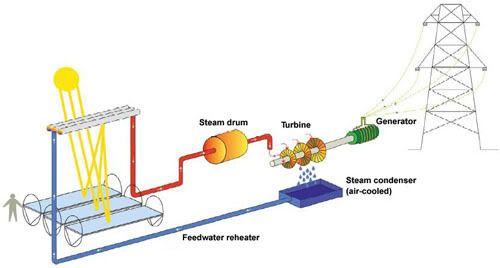Baseload renewable power at utility-scale is here and it is US based Ausra Inc who has the solution with it's Solar thermal technology.
The technology was originally developed in Australia by Dr. David Mills. Unfortunately for the Australian economy Dr Mills had to take his technology to the United States to get the funding he required to continue this technology through to production stage.
We believe that Ausra Inc's Solar thermal technology is the single most promising of all technologies we have shown at PaleBluDot, in it's ability to reduce greenhouse emissions on a global scale and to do so at a comparable cost to coal and nuclear power generation.
So how does the Ausra Solar Thermal System work?
Ausra uses a technology called, Compact Linear Fresnel Reflector (CLFR). This idea was originally conceived in the early 1990s by Ausra's founders in Australia. The system works by reflecting sunlight off mirrors and onto a collecting tube, this tube is filled with water and as such will produce high temperature, pressurised steam. The steam then drives a turbine generator which produces electricity. (see image below)

Image courtesy of Ausra Inc
Oct 07, ABC Australia video on Ausra's Solar thermal system
Ausra on ABC 7.30 report via YouTube
POST CONTINUES more about Ausra's system
Aren't solar thermal systems already being used?
It is true that solar thermal systems have been used for a while now, such as the system built in the Mojave Desert in the 1980s by LUZ Industries and now owned by Solel. This system uses Parabolic dishes which reflect the suns energy to heat an oil filled tube. The heated oil is then put through a heat exchange unit to boil water and produce steam, spin turbines and produce electricity.
Another solar thermal system recently implemented is the PS10 Solar thermal tower by Abengoa Solar. This system uses a field of reflectors which focus sunlight at the top of a tower where a boiler is located which absorbs the heat and produces steam. This once again drives a turbine generator to produce electricity.
So most solar thermal systems basically work the same way. Heat is collected and used to boil water, produce steam and drive a turbine generator. In fact most power systems work this way, even coal and nuclear.
So what's special about the CLFR system by Ausra?
Low cost design
"The CLFR system retains a key advantage of troughs – fewer foundations and positioning motors per square meter of mirror – and a key advantage of the PS-10 tower system – direct steam generation and energy storage. Compared to trough systems, the CLFR system reduces costs by replacing special heat-curved reflectors with standard flat glass, and keeps all mirrors close to the ground, lowering wind loads and steel usage."
Cheaper electricity production costs than clean coal or nuclear
Vinod Khosla, (the founder of SUN Microsystems and venture capitalist investing in Ausra) has the following to say regarding the power generation costs using Ausra's CLFR system.
"We think we can move much faster than nuclear and on an unsubsidised basis, we will be cheaper than nuclear power, and we should be cheaper than IGCC [integrated gasification combined cycle] coal-based power generation,"
Power, day and night
Ausra have also developed a system of storing the heat that they collect from the sun for up to 16-20 hours. This heat can then be delivered to drive the turbines during the night or when cloudy weather is experienced.
So what happens when there is more than a couple of days cloudy weather?. I posed this question to John O'Donnell, who is the Executive Vice President of Ausra Inc. (see John's reply below)
"By placing plants in multiple locations the localized weather risk can be drastically reduced. Fossil-fired power plants and/or fossil supplementation of solar plants (burning gas on cloudy days to maintain energy output) can cover shortfalls, especially in the earlier phases when less transmission links the regions. Building long-range transmission essentially eliminates weather risk."
Recent developments at Ausra
Ausra and PG&E in 177 Megawatt Solar Thermal Power Agreement
"SAN FRANCISCO, Calif.—Nov. 5, 2007—Pacific Gas and Electric Company today announced that it has entered into a 177 megawatt solar thermal power purchasing agreement with Ausra Inc. The project, to be located in central California, is being developed by Ausra."
The 177MW plant is basically just a starting point for Ausra with GW plants being discussed.
See the full details here –>Ausra and PG&E Power Agreement
Ausra will be manufacturing it's own materials
"LAS VEGAS—Dec. 13, 2007—Ausra Inc., the developer of utility-scale solar thermal power, announced today it is building the first U.S. manufacturing plant for solar thermal power systems in Las Vegas. The 130,000-square-foot, highly automated manufacturing and distribution center will produce the reflectors, towers, absorber tubes, and other key components of the company's solar thermal power plants."
See the full details here –>Ausra's manufacturing plant in Nevada
Conclusion
Ausra's Solar thermal system using CLFR technology can provide Baseload, utility scale electricity at market competitive prices, without the CO2 emissions or Nuclear waste. The Ausra system can be implemented quickly and has potential in many countries throughout the world. Ausra is definitely becoming a key player in the world energy market.
No comments:
Post a Comment